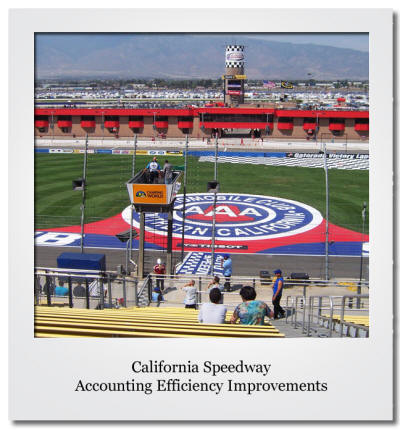
California Speedway Concessions
 I was the second Controller of California Speedway Concessions, being assigned this position at the beginning of the second year of operations. This facility had two primary events each year, NASCAR in the spring and Indy carts in the fall. Some years there were some smaller events scattered throughout the year. My job was to travel to Fontana, California each time there was an event and direct the accounting and cash functions.
I was the second Controller of California Speedway Concessions, being assigned this position at the beginning of the second year of operations. This facility had two primary events each year, NASCAR in the spring and Indy carts in the fall. Some years there were some smaller events scattered throughout the year. My job was to travel to Fontana, California each time there was an event and direct the accounting and cash functions.
When I arrived in Fontana two weeks before my first NASCAR event, I reviewed the procedures my predecessor had put in place. My conclusion was that although the procedures were generally sound, there were changes that could be made to improve efficiency.
During the three day event, stand managers from the twelve main concession stands made cash drops throughout the day to a drop safe located in the back of the stand. Portable stands located near the permanent stands also made cash drops at the closest main stand. The drops were recorded on drop logs by bag number.
Security picked up the bags periodically throughout the day and brought them to the cash room. Each bag was counted by a cash room cashier and agreed to the completed cash slip inside the bag. Verified cash slips were given to the Cash Room Manager who keyed the amount on an Excel spreadsheet by concession stand. When all cash was counted, the Cash Room Manager added the amounts on a calculator by stand to calculate the total cash dropped. I changed the Excel spreadsheet so that the spreadsheet automatically totaled by stand, thus improving accuracy and dramatically cutting down the time to add the amounts dropped for over 100 concession stands.
The prior Controller balanced all 100 concession stands every night of the weekend. After Saturday’s activity, the Controller spent the entire night recounting stands that had significant variances. On Sunday, by far the busiest day of the week end, the Controller, having had no sleep the prior night, was miserable and barely able to function.
Each charity group had the same concession stands all weekend and was paid commission on the sales the group generated. I changed the procedure so that product was tracked for the entire weekend for each stand. Instead of counting inventory every night, we counted the opening inventory on Thursday and the closing inventory Sunday night. Recounts, where necessary, were done on Monday morning when everyone was fresh. As a result, the Controller was sharp and alert on the Sunday, the busiest day. We had fewer counting errors and spent less time recounting inventory.
The Daily Sales Report was a spreadsheet used to calculate Food, Beer, and Liquor Sales for the concessions operation. It was designed for another Sportservice operation before Microsoft had tabs in the spreadsheet. In its inaugural season, the Daily Sales Report was adapted to California Speedway. The spreadsheet was very awkward. Different parts of the sales calculation were input into different parts of the spreadsheet. Calculations were difficult to follow because they referenced a multitude of other cells scattered throughout the spreadsheet. While the spreadsheet worked satisfactorily for an operation that functioned daily, the person entering the data at California Speedway had not seen the spreadsheet in six months and had to refamiliarize herself with its mechanics. The result was a data entry process that was very time consuming.
I scrapped the Daily Sales Report spreadsheet and designed a new spreadsheet where I simplified the process. All data was input in one tab. Another tab calculated sales tax and net sales. The third tab sorted the results in a sequence that made it easy to key the data into Sportservice’s General Ledger system. Calculations were easy to follow because they took data from common areas. As a result, time spent in calculating sales each day was reduced by 75%.
The first year that I was Controller, four other accountants were sent from the main office in Buffalo to do the accounting for the race weekend. By increasing the efficiency in the way we performed our tasks and utilizing the full-time secretary at the speedway to process accounts payable invoices for payment, I was able to cut these accountants to two for the race weekend.
(RETURN)
